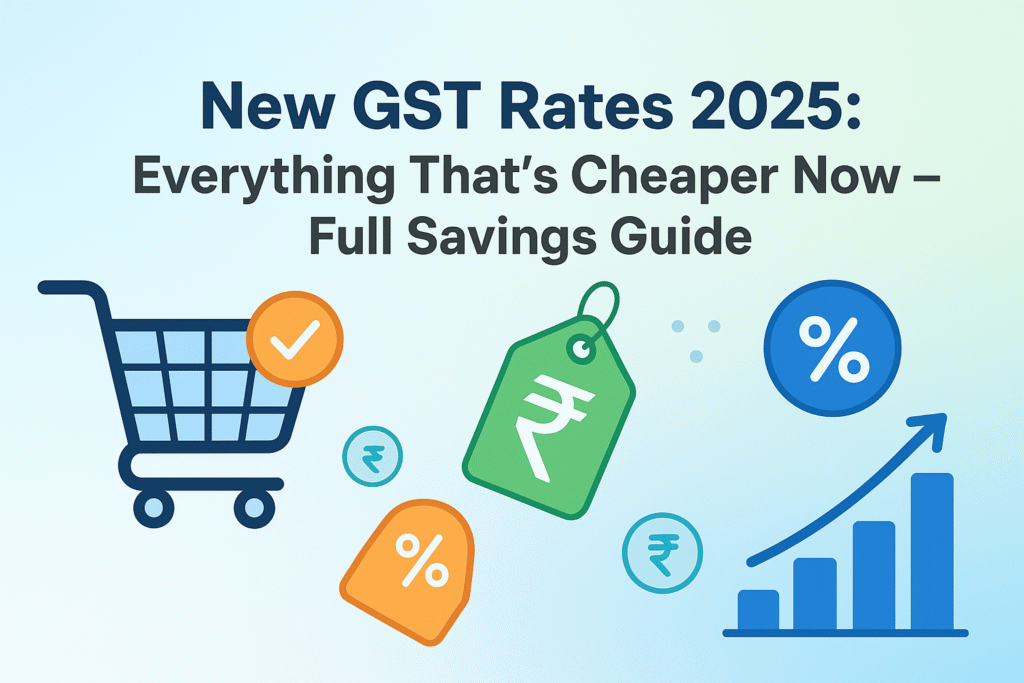
What is the GST Reform 2025?
The GST Reform 2025 is a pivotal overhaul of India’s indirect tax system, shifting from four main slabs to fewer, easier-to-understand rates – 5%, 18%, and a special 40% for luxury or sin goods. Most everyday essentials are now being taxed at lower rates, making them more affordable, while the high-end luxury and good segment faces a higher tax. For a deep dive into the policy background, visit: GST Reform 2025 – India Moves to 5–18% Slabs with Essentials GST-Free.
GST 2025 Rate Structure & Main Highlights
- 5% GST: Now covers most food, daily-use items, personal care products, standard medicines, and many household appliances.
- 18% GST: Applies to standard consumer and electronic goods, small vehicles, most auto parts, and services.
- 0% (Nil) GST: Ultra-high temperature (UHT) milk, packaged paneer, breads, select antibiotics & lifesaving medicines, insurance premiums, charitable health & education services, and basic school supplies enjoy total exemption.
- 40% GST: Reserved for sin and luxury goods such as tobacco, pan masala, aerated and caffeinated beverages, high-end cars, and select luxury appliances.
- 12% and 28% slabs abolished for most products. Almost all items were reclassified to new slabs from September 22, 2025.
Complete List: Items That Got Cheaper
Foods, Dairy & Kitchen Essentials
| Item | New GST Rate | Previous Rate |
| UHT Milk, Paneer, Roti | 0% | 5% |
| Butter, Ghee, Cheese | 5% | 12–18% |
| Namkeen, Snacks, Biscuits | 5% | 12–18% |
| Pasta, Chocolates, Baked Goods | 5% | 12–18% |
| Dried fruits/Nuts, Starches, Malt | 5% | 12–18% |
| Packaged foods (noodles, jams) | 5% | 12–18% |
Example savings: Ghee prices have dropped by ₹40–70 per liter; butter and paneer are also significantly more affordable.
Health, Medicines & Insurance
- Lifesaving drugs (33 named) and selected cancer/rare disease meds: 0% GST.
- Most other medicines: now just 5% GST (from 12% previously).
- Medical kits, diagnostic kits, and equipment: 5% (was 12%).
- Health & life insurance (all types): 0% (down from 18%), resulting in substantial annual savings for policyholders. Home Appliances, TV & Electronics
Home Appliances, TV & Electronics
| Item | New GST | Old GST |
| Air conditioners, refrigerators | 18% | 28% |
| TVs (all sizes) | 18% | 28% |
| Dishwashers | 18% | 28% |
| Fans, kitchen appliances | 18% | 18–28% |
Example savings:
- AC’s: ₹2,800–₹5,900 lower.
- Large TVs: ₹2,500–₹85,800 lower depending on size.
Personal Care & Toiletries
- Hair oil, soaps, toothpaste, shaving products: 5% (down from 18%).
- Baby care: Diapers & essentials are now cheaper under the 5% bracket.
Automobiles & Transport:
| Vehicle Type | New GST Rate | Old Rate | Example Savings |
| Scooters, bikes ≤350cc | 18% | 28% | Up to ₹18,800 cheaper |
| Entry-level cars/hatchbacks | 18% | 28% | Up to ₹85,000 saved |
| Mid-range SUVs/cars | 18% | 28% | Up to ₹1.56 lakh dropped |
| Premium/luxury vehicles | 40% | 28%+cess | Some cuts, but for select models |
- All auto parts standardized at 18% (streamlines supply chain).
Construction, Farming & Student Items
- Cement: 18% (down from 28%), reducing home/infrastructure costs.
- Agricultural equipment: 5% (down from 12–18%).
- Fertilizer inputs: Now cheaper, aiding farmers.
- Stationery (books, pencils, erasers): 0% (previously 12%), especially helping students and parents.
Hospitality, Hotels & Entertainment
- Hotels up to ₹7,500/night: 5% (previously 12%).
- Movie tickets ≤₹100: 5% (was 12%), above ₹100 now at 40% for luxury screens.
- Charitable education and hospital services: 0%.
What Got Costlier? – Higher GST on Sin & Luxury Goods
The GST Council introduced a new 40% slab for sin and luxury goods:
- Tobacco, cigarettes, pan masala: 40% (plus existing cess).
- Aerated, sugary, and caffeinated drinks: 40%.
- Luxury cars & yachts, aircraft, premium appliances, cinema tickets >₹100: 40%.
Who benefits most? – Consumer Savings Scenarios
- Middle-class families: Massive savings on food, kitchen, electronics, and vehicles.
- Young parents: Lower costs for diapers, baby foods, and educational supplies.
- Patients/elderly: Insurance and medicine spend drops sharply.
- Farmers/home builders: Cheaper machinery, fertilizer, and construction costs mean higher productivity and homeownership access.
How the New GST Impacts Businesses
- MSMEs and retail: Simpler filing, fewer slabs to track, and broader exemption limit.
- Less working capital stuck in input tax credits due to simplified rates.
- Faster refunds under new digital compliance rules.
- Boosts domestic competitiveness by cutting supply chain complexity.
FAQs on New GST Rates 2025
Q1. Which items are completely tax-free under GST 2025?
- A: UHT milk, pre-packed paneer, Indian breads, certain lifesaving drugs, major insurance products, educational and health charity services, and essential stationery for students are now GST-exempt.
Q2. What are the core GST slabs from September 2025?
- A: 0% (nil), 5%, 18%, and 40% (for luxury/sin goods).
Q3. Are vehicle prices really coming down?
- A: Yes, entry-level cars, motorcycles, and most two-wheelers see significant price drops (from ₹5,600 up to ₹1.56 lakh), and small cars are now taxed at just 18%.
Q4. Is there any benefit for homebuyers or builders?
- A: Yes! Cement is now at 18% (from 28%), making construction significantly more affordable; allied products and appliances also attract lower taxes.
Q5. What are ‘sin goods,’ and why the higher rate?
- A: Sin goods include tobacco, pan masala, and sugary/aerated beverages, now taxed at 40% plus existing cess to discourage consumption and fund health programs.
Q6. How are digital compliance and refunds improving?
- A: GST-2.0 brings digital-first filing, faster refunds, simplified input tax credits, and AI-based fraud monitoring for SME and large businesses.
Q7. Are there transitional provisions or exceptions?
- A: Tobacco and related goods will follow the new slab after settlement of previous cess-related loans.
Conclusion – The New GST, A Savings Revolution
India’s GST 2025 reform is an unprecedented move to make the tax system fairer, simpler, and more efficient, putting money back in the hands of consumers and streamlining business operations. Essentials are undeniably cheaper, savings are tangible for every household, and the path for industry growth is clearer than ever before. The move marks a dawn for a pro-consumer, pro-growth GST regime.

